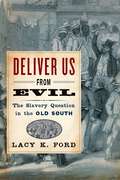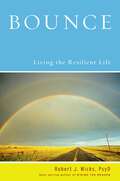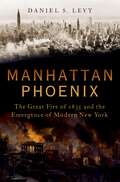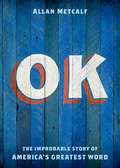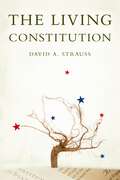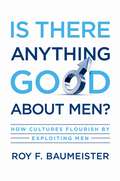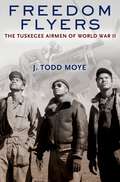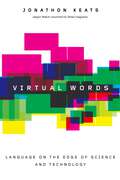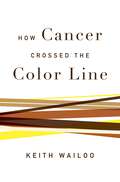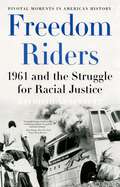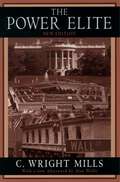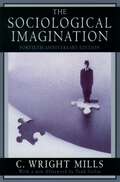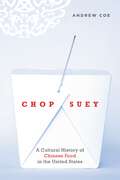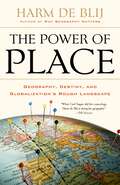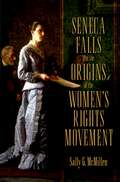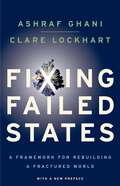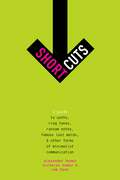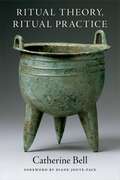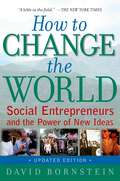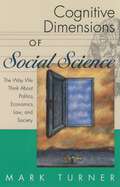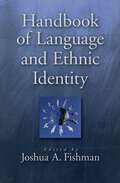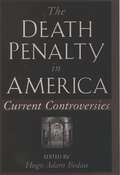- Table View
- List View
Deliver Us from Evil: The Slavery Question in the Old South
by Lacy K. FordA major contribution to our understanding of slavery in the early republic, Deliver Us from Evil illuminates the white South's twisted and tortured efforts to justify slavery, focusing on the period from the drafting of the federal constitution in 1787 through the age of Jackson. Drawing heavily on primary sources, including newspapers, government documents, legislative records, pamphlets, and speeches, Lacy K. Ford recaptures the varied and sometimes contradictory ideas and attitudes held by groups of white southerners as they tried to square slavery with their democratic ideals. He excels at conveying the political, intellectual, economic, and social thought of leading white southerners, vividly recreating the mental world of the varied actors and capturing the vigorous debates over slavery. He also shows that there was not one antebellum South but many, and not one southern white mindset but several, with the debates over slavery in the upper South quite different in substance from those in the deep South. In the upper South, where tobacco had fallen into comparative decline by 1800, debate often centered on how the area might reduce its dependence on slave labor and "whiten" itself, whether through gradual emancipation and colonization or the sale of slaves to the cotton South. During the same years, the lower South swirled into the vortex of the "cotton revolution," and that area's whites lost all interest in emancipation, no matter how gradual or fully compensated. An ambitious, thought-provoking, and highly insightful book, Deliver Us from Evil makes an important contribution to the history of slavery in the United States, shedding needed light on the white South's early struggle to reconcile slavery with its Revolutionary heritage.
Bounce: Living the Resilient Life
by Robert J. WicksStress is a fact of modern life. And as more and more people face greater financial insecurity, longer work hours, and the increasingly complex personal and social demands of our fast-paced, multi-tasking, high-tech lifestyle, finding healthy ways to handle stress is more important than ever. In Bounce: Living the Resilient Life, Robert Wicks shows you not just how to manage stress, but how to transform stressful situations into opportunities to live a more meaningful, self-aware, and compassionate life. Wicks makes available to everyone techniques he has used for over 30 years in helping physicians, nurses, psychotherapists, educators, social workers, ministers, and relief workers not only survive but flourish in highly stressful occupations. You'll learn a wide range of methods--normally reserved for those in helping and healing professions--to help you bounce back from stress and live life to the fullest. Bounce shows you how to: · Recognize the insidious nature of denial and avoidance as responses to stress · Employ psychologically powerful approaches to self-awareness · Improve self-talk through the use of cognitive behavioral principles · Apply daily-debriefing techniques · Utilize a structured reflection guide to uncover areas that require special attention · Incorporate silence, solitude, and mindfulness into daily life · Stop the drain of valuable emotional energy caused by toxic life situations and unexamined attitudes and beliefs · And much more Most important, Bounce helps you develop your own self-care protocol and personal renewal program, based on an honest assessment of your needs, life situation, and habitual ways of dealing--or failing to deal--with stress. Insightful, practical, and filled with wise guidance, Bounce shows us all how to live with greater resilience in a world that grows more stressful by the day.
Manhattan Phoenix: The Great Fire of 1835 and the Emergence of Modern New York
by Daniel S LevyShows vividly how the Great Fire of 1835, which nearly leveled Manhattan also created the ashes from which the city was reborn. On a freezing December night almost two centuries ago, a fire erupted in lower Manhattan. The city's inhabitants, though accustomed to blazes in a town with so many wooden structures, a spotty water supply, and a decentralized fire department, looked on in horror at the scale of this one. Philip Hone, a former mayor of New York, wrote in his diary how "the progress of the flames, like flashes of lightning, communicated in every direction, and a few minutes sufficed to level the lofty edifices on every side." By the time the fire was extinguished, a huge swath of land had been transformed from a thriving business center into the "Burnt District," an area roughly the same size as was devastated during the September 11th attack. In the end, nearly 700 buildings were destroyed. So vast was the conflagration that it was immediately and henceforth known as the Great Fire of 1835. Manhattan Phoenix reveals how New York emerged from the disaster to become a global powerhouse merely a quarter of a century later. Daniel S. Levy's book charts the city's almost miraculous growth during the early 19th century by focusing on the topics that shaped its destiny, starting with fire but including water, land, disease, culture, and politics, interweaving the lives of New Yorkers who took part in its transformation. Some are well-known, including the land baron John Jacob Astor. Others less so, as with the Bowery Theatre impresario Thomas Hamblin and the African-American restaurateur Thomas Downing. The book celebrates Fire Chief James Gulick, who battled the Great Fire, examines the designs of the architect Alexander Jackson Davis who built marble palaces for the rich, follows the abolitionist Arthur Tappan, chronicles the career of the merchant Alexander Stewart, and reveals how the engineer John Bloomfield Jervis succeeded in bringing clean water into homes. The city's resurrection likewise owed much to such visionaries as Frederick Law Olmsted and Calvert Vaux, who designed Central Park, creating the refuge that it remains to this day. Manhattan Phoenix offers the story of a city rising from the ashes to fulfill its destiny to grow into one of the world's greatest metropolisesand in no small part due to catastrophe. It is, in other words, a New York story.
OK: The Improbable Story of America's Greatest Word
by Allan MetcalfIt is said to be the most frequently spoken (or typed) word on the planet, more common than an infant's first word ma or the ever-present beverage Coke. It was even the first word spoken on the moon. It is "OK"--the most ubiquitous and invisible of American expressions, one used countless times every day. Yet few of us know the hidden history of OK--how it was coined, what it stood for, and the amazing extent of its influence. Allan Metcalf, a renowned popular writer on language, here traces the evolution of America's most popular word, writing with brevity and wit, and ranging across American history with colorful portraits of the nooks and crannies in which OK survived and prospered. He describes how OK was born as a lame joke in a newspaper article in 1839--used as a supposedly humorous abbreviation for "oll korrect" (ie, "all correct")--but should have died a quick death, as most clever coinages do. But OK was swept along in a nineteenth-century fad for abbreviations, was appropriated by a presidential campaign (one of the candidates being called "Old Kinderhook"), and finally was picked up by operators of the telegraph. Over the next century and a half, it established a firm toehold in the American lexicon, and eventually became embedded in pop culture, from the "I'm OK, You're OK" of 1970's transactional analysis, to Ned Flanders' absurd "Okeley Dokeley!" Indeed, OK became emblematic of a uniquely American attitude, and is one of our most successful global exports. "An appealing and informative history of OK." --Washington Post Book World "After reading Metcalf's book, it's easy to accept his claim that OK is 'America's greatest word.'" --Erin McKean, Boston Globe "Entertaininga treat for logophiles." --Kirkus Reviews "Metcalf makes you acutely aware of how ubiquitous and vital the word has become." --Jeremy McCarter, Newsweek
The Living Constitution (Inalienable Rights)
by David A. StraussSupreme Court Justice Antonin Scalia once remarked that the theory of an evolving, "living" Constitution effectively "rendered the Constitution useless." He wanted a "dead Constitution," he joked, arguing it must be interpreted as the framers originally understood it. In The Living Constitution, leading constitutional scholar David Strauss forcefully argues against the claims of Scalia, Clarence Thomas, Robert Bork, and other "originalists," explaining in clear, jargon-free English how the Constitution can sensibly evolve, without falling into the anything-goes flexibility caricatured by opponents. The living Constitution is not an out-of-touch liberal theory, Strauss further shows, but a mainstream tradition of American jurisprudence--a common-law approach to the Constitution, rooted in the written document but also based on precedent. Each generation has contributed precedents that guide and confine judicial rulings, yet allow us to meet the demands of today, not force us to follow the commands of the long-dead Founders. Strauss explores how judicial decisions adapted the Constitution's text (and contradicted original intent) to produce some of our most profound accomplishments: the end of racial segregation, the expansion of women's rights, and the freedom of speech. By contrast, originalism suffers from fatal flaws: the impossibility of truly divining original intent, the difficulty of adapting eighteenth-century understandings to the modern world, and the pointlessness of chaining ourselves to decisions made centuries ago. David Strauss is one of our leading authorities on Constitutional law--one with practical knowledge as well, having served as Assistant Solicitor General of the United States and argued eighteen cases before the United States Supreme Court. Now he offers a profound new understanding of how the Constitution can remain vital to life in the twenty-first century.
Is There Anything Good About Men?: How Cultures Flourish by Exploiting Men
by Roy F. BaumeisterHave men really been engaged in a centuries-old conspiracy to exploit and oppress women? Have the essential differences between men and women really been erased? Have men now become unnecessary? Are they good for anything at all? In Is There Anything Good About Men?, Roy Baumeister offers provocative answers to these and many other questions about the current state of manhood in America. Baumeister argues that relations between men and women are now and have always been more cooperative than antagonistic, that men and women are different in basic ways, and that successful cultures capitalize on these differences to outperform rival cultures. Amongst our ancestors---as with many other species--only the alpha males were able to reproduce, leading them to take more risks and to exhibit more aggressive and protective behaviors than women, whose evolutionary strategies required a different set of behaviors. Whereas women favor and excel at one-to-one intimate relationships, men compete with one another and build larger organizations and social networks from which culture grows. But cultures in turn exploit men by insisting that their role is to achieve and produce, to provide for others, and if necessary to sacrifice themselves. Baumeister shows that while men have greatly benefited from the culture they have created, they have also suffered because of it. Men may dominate the upper echelons of business and politics, but far more men than women die in work-related accidents, are incarcerated, or are killed in battle--facts nearly always left out of current gender debates. Engagingly written, brilliantly argued, and based on evidence from a wide range of disciplines, Is There Anything Good About Men? offers a new and far more balanced view of gender relations.
Freedom Flyers: The Tuskegee Airmen of World War II (Oxford Oral History Series)
by J. Todd MoyeAs the country's first African American military pilots, the Tuskegee Airmen fought in World War II on two fronts: against the Axis powers in the skies over Europe and against Jim Crow racism and segregation at home. Although the pilots flew more than 15,000 sorties and destroyed more than 200 German aircraft, their most far-reaching achievement defies quantification: delivering a powerful blow to racial inequality and discrimination in American life. In this inspiring account of the Tuskegee Airmen, historian J. Todd Moye captures the challenges and triumphs of these brave pilots in their own words, drawing on more than 800 interviews recorded for the National Park Service's Tuskegee Airmen Oral History Project. Denied the right to fully participate in the U.S. war effort alongside whites at the beginning of World War II, African Americans--spurred on by black newspapers and civil rights organizations such as the NAACP--compelled the prestigious Army Air Corps to open its training programs to black pilots, despite the objections of its top generals. Thousands of young men came from every part of the country to Tuskegee, Alabama, in the heart of the segregated South, to enter the program, which expanded in 1943 to train multi-engine bomber pilots in addition to fighter pilots. By the end of the war, Tuskegee Airfield had become a small city populated by black mechanics, parachute packers, doctors, and nurses. Together, they helped prove that racial segregation of the fighting forces was so inefficient as to be counterproductive to the nation's defense. Freedom Flyers brings to life the legacy of a determined, visionary cadre of African American airmen who proved their capabilities and patriotism beyond question, transformed the armed forces--formerly the nation's most racially polarized institution--and jump-started the modern struggle for racial equality.
Virtual Words: Language on the Edge of Science and Technology
by Jonathon KeatsThe technological realm provides an unusually active laboratory not only for new ideas and products but also for the remarkable linguistic innovations that accompany and describe them. How else would words like qubit (a unit of quantum information), crowdsourcing (outsourcing to the masses), or in vitro meat (chicken and beef grown in an industrial vat) enter our language? In Virtual Words: Language on the Edge of Science and Technology, Jonathon Keats, author of Wired Magazine's monthly Jargon Watch column, investigates the interplay between words and ideas in our fast-paced tech-driven use-it-or-lose-it society. In 28 illuminating short essays, Keats examines how such words get coined, what relationship they have to their subject matter, and why some, like blog, succeed while others, like flog, fail. Divided into broad categories--such as commentary, promotion, and slang, in addition to scientific and technological neologisms--chapters each consider one exemplary word, its definition, origin, context, and significance. Examples range from microbiome (the collective genome of all microbes hosted by the human body) and unparticle (a form of matter lacking definite mass) to gene foundry (a laboratory where artificial life forms are assembled) and singularity (a hypothetical future moment when technology transforms the whole universe into a sentient supercomputer). Together these words provide not only a survey of technological invention and its consequences, but also a fascinating glimpse of novel language as it comes into being. No one knows this emerging lexical terrain better than Jonathon Keats. In writing that is as inventive and engaging as the language it describes, Virtual Words offers endless delights for word-lovers, technophiles, and anyone intrigued by the essential human obsession with naming.
How Cancer Crossed the Color Line
by Keith WailooIn the course of the 20th century, cancer went from being perceived as a white woman's nemesis to a "democratic disease" to a fearsome threat in communities of color. Drawing on film and fiction, on medical and epidemiological evidence, and on patients' accounts, Keith Wailoo tracks this transformation in cancer awareness, revealing how not only awareness, but cancer prevention, treatment, and survival have all been refracted through the lens of race. Spanning more than a century, the book offers a sweeping account of the forces that simultaneously defined cancer as an intensely individualized and personal experience linked to whites, often categorizing people across the color line as racial types lacking similar personal dimensions. Wailoo describes how theories of risk evolved with changes in women's roles, with African-American and new immigrant migration trends, with the growth of federal cancer surveillance, and with diagnostic advances, racial protest, and contemporary health activism. The book examines such powerful and transformative social developments as the mass black migration from rural south to urban north in the 1920s and 1930s, the World War II experience at home and on the war front, and the quest for civil rights and equality in health in the 1950s and '60s. It also explores recent controversies that illuminate the diversity of cancer challenges in America, such as the high cancer rates among privileged women in Marin County, California, the heavy toll of prostate cancer among black men, and the questions about why Vietnamese-American women's cervical cancer rates are so high. A pioneering study, How Cancer Crossed the Color Line gracefully documents how race and gender became central motifs in the birth of cancer awareness, how patterns and perceptions changed over time, and how the "war on cancer" continues to be waged along the color line.
How Cancer Crossed the Color Line
by Keith WailooIn the course of the 20th century, cancer went from being perceived as a white woman's nemesis to a "democratic disease" to a fearsome threat in communities of color. Drawing on film and fiction, on medical and epidemiological evidence, and on patients' accounts, Keith Wailoo tracks this transformation in cancer awareness, revealing how not only awareness, but cancer prevention, treatment, and survival have all been refracted through the lens of race. Spanning more than a century, the book offers a sweeping account of the forces that simultaneously defined cancer as an intensely individualized and personal experience linked to whites, often categorizing people across the color line as racial types lacking similar personal dimensions. Wailoo describes how theories of risk evolved with changes in women's roles, with African-American and new immigrant migration trends, with the growth of federal cancer surveillance, and with diagnostic advances, racial protest, and contemporary health activism. The book examines such powerful and transformative social developments as the mass black migration from rural south to urban north in the 1920s and 1930s, the World War II experience at home and on the war front, and the quest for civil rights and equality in health in the 1950s and '60s. It also explores recent controversies that illuminate the diversity of cancer challenges in America, such as the high cancer rates among privileged women in Marin County, California, the heavy toll of prostate cancer among black men, and the questions about why Vietnamese-American women's cervical cancer rates are so high. A pioneering study, How Cancer Crossed the Color Line gracefully documents how race and gender became central motifs in the birth of cancer awareness, how patterns and perceptions changed over time, and how the "war on cancer" continues to be waged along the color line.
Freedom Riders: 1961 and the Struggle for Racial Justice (Pivotal Moments in American History)
by Raymond ArsenaultThey were black and white, young and old, men and women. In the spring and summer of 1961, they put their lives on the line, riding buses through the American South to challenge segregation in interstate transport. Their story is one of the most celebrated episodes of the civil rights movement, yet a full-length history has never been written until now. In these pages, acclaimed historian Raymond Arsenault provides a gripping account of six pivotal months that jolted the consciousness of America. The Freedom Riders were greeted with hostility, fear, and violence. They were jailed and beaten, their buses stoned and firebombed. In Alabama, police stood idly by as racist thugs battered them. When Martin Luther King met the Riders in Montgomery, a raging mob besieged them in a church. Arsenault recreates these moments with heart-stopping immediacy. His tightly braided narrative reaches from the White House--where the Kennedys were just awakening to the moral power of the civil rights struggle--to the cells of Mississippi's infamous Parchman Prison, where Riders tormented their jailers with rousing freedom anthems. Along the way, he offers vivid portraits of dynamic figures such as James Farmer, Diane Nash, John Lewis, and Fred Shuttlesworth, recapturing the drama of an improbable, almost unbelievable saga of heroic sacrifice and unexpected triumph. The Riders were widely criticized as reckless provocateurs, or "outside agitators." But indelible images of their courage, broadcast to the world by a newly awakened press, galvanized the movement for racial justice across the nation. Freedom Riders is a stunning achievement, a masterpiece of storytelling that will stand alongside the finest works on the history of civil rights.
The Power Elite
by C. Wright MillsFirst published in 1956, The Power Elite stands as a contemporary classic of social science and social criticism. C. Wright Mills examines and critiques the organization of power in the United States, calling attention to three firmly interlocked prongs of power: the military, corporate, and political elite. The Power Elite can be read as a good account of what was taking place in America at the time it was written, but its underlying question of whether America is as democratic in practice as it is in theory continues to matter very much today. What The Power Elite informed readers of in 1956 was how much the organization of power in America had changed during their lifetimes, and Alan Wolfe's astute afterword to this new edition brings us up to date, illustrating how much more has changed since then. Wolfe sorts out what is helpful in Mills' book and which of his predictions have not come to bear, laying out the radical changes in American capitalism, from intense global competition and the collapse of communism to rapid technological transformations and ever changing consumer tastes. The Power Elite has stimulated generations of readers to think about the kind of society they have and the kind of society they might want, and deserves to be read by every new generation.
The Sociological Imagination
by C. Wright MillsC. Wright Mills is best remembered for his highly acclaimed work The Sociological Imagination, in which he set forth his views on how social science should be pursued. Hailed upon publication as a cogent and hard-hitting critique, The Sociological Imagination took issue with the ascendant schools of sociology in the United States, calling for a humanist sociology connecting the social, personal, and historical dimensions of our lives. The sociological imagination Mills calls for is a sociological vision, a way of looking at the world that can see links between the apparently private problems of the individual and important social issues.
Chop Suey: A Cultural History of Chinese Food in the United States
by Andrew CoeIn 1784, passengers on the ship Empress of China became the first Americans to land in China, and the first to eat Chinese food. Today there are over 40,000 Chinese restaurants across the United States--by far the most plentiful among all our ethnic eateries. Now, in Chop Suey Andrew Coe provides the authoritative history of the American infatuation with Chinese food, telling its fascinating story for the first time. It's a tale that moves from curiosity to disgust and then desire. From China, Coe's story travels to the American West, where Chinese immigrants drawn by the 1848 Gold Rush struggled against racism and culinary prejudice but still established restaurants and farms and imported an array of Asian ingredients. He traces the Chinese migration to the East Coast, highlighting that crucial moment when New York "Bohemians" discovered Chinese cuisine--and for better or worse, chop suey. Along the way, Coe shows how the peasant food of an obscure part of China came to dominate Chinese-American restaurants; unravels the truth of chop suey's origins; reveals why American Jews fell in love with egg rolls and chow mein; shows how President Nixon's 1972 trip to China opened our palates to a new range of cuisine; and explains why we still can't get dishes like those served in Beijing or Shanghai. The book also explores how American tastes have been shaped by our relationship with the outside world, and how we've relentlessly changed foreign foods to adapt to them our own deep-down conservative culinary preferences. Andrew Coe's Chop Suey: A Cultural History of Chinese Food in the United States is a fascinating tour of America's centuries-long appetite for Chinese food. Always illuminating, often exploding long-held culinary myths, this book opens a new window into defining what is American cuisine.
The Power of Place: Geography, Destiny, and Globalization's Rough Landscape
by Harm de BlijThe world is not as mobile or as interconnected as we like to think. As Harm de Blij argues in The Power of Place, in crucial ways--from the uneven distribution of natural resources to the unequal availability of opportunity--geography continues to hold billions of people in its grip. We are all born into natural and cultural environments that shape what we become, individually and collectively. From our "mother tongue" to our father's faith, from medical risks to natural hazards, where we start our journey has much to do with our destiny. Hundreds of millions of farmers in the river basins of Asia and Africa, and tens of millions of shepherds in isolated mountain valleys from the Andes to Kashmir, all live their lives much as their distant ancestors did, remote from the forces of globalization. Incorporating a series of persuasive maps, De Blij describes the tremendously varied environments across the planet and shows how migrations between them are comparatively rare. De Blij also looks at the ways we are redefining place so as to make its power even more potent than it has been, with troubling implications.
Seneca Falls and the Origins of the Women's Rights Movement (Pivotal Moments in American History)
by Sally McMillenIn a quiet town of Seneca Falls, New York, over the course of two days in July, 1848, a small group of women and men, led by Elizabeth Cady Stanton and Lucretia Mott, held a convention that would launch the woman's rights movement and change the course of history. The implications of that remarkable convention would be felt around the world and indeed are still being felt today. In Seneca Falls and the Origins of the Woman's Rights Movement, the latest contribution to Oxford's acclaimed Pivotal Moments in American History series, Sally McMillen unpacks, for the first time, the full significance of that revolutionary convention and the enormous changes it produced. The book covers 50 years of women's activism, from 1840-1890, focusing on four extraordinary figures--Lucretia Mott, Elizabeth Cady Stanton, Lucy Stone, and Susan B. Anthony. McMillen tells the stories of their lives, how they came to take up the cause of women's rights, the astonishing advances they made during their lifetimes, and the lasting and transformative effects of the work they did. At the convention they asserted full equality with men, argued for greater legal rights, greater professional and education opportunities, and the right to vote--ideas considered wildly radical at the time. Indeed, looking back at the convention two years later, Anthony called it "the grandest and greatest reform of all time--and destined to be thus regarded by the future historian." In this lively and warmly written study, Sally McMillen may well be the future historian Anthony was hoping to find. A vibrant portrait of a major turning point in American women's history, and in human history, this book is essential reading for anyone wishing to fully understand the origins of the woman's rights movement.
Fixing Failed States: A Framework for Rebuilding a Fractured World
by Ashraf Ghani Clare LockhartToday between forty and sixty nations, home to more than one billion people, have either collapsed or are teetering on the brink of failure. The world's worst problems--terrorism, drugs and human trafficking, absolute poverty, ethnic conflict, disease, genocide--originate in such states, and the international community has devoted billions of dollars to solving the problem. Yet by and large the effort has not succeeded. Ashraf Ghani and Clare Lockhart have taken an active part in the effort to save failed states for many years, serving as World Bank officials, as advisers to the UN, and as high-level participants in the new government of Afghanistan. In Fixing Failed States, they describe the issue--vividly and convincingly--offering an on-the-ground picture of why past efforts have not worked and advancing a groundbreaking new solution to this most pressing of global crises. For the paperback edition, they have added a new preface that addresses the continuing crisis in light of ongoing governance problems in weak states like Afghanistan and the global financial recession. As they explain, many of these countries already have the resources they need, if only we knew how to connect them to global knowledge and put them to work in the right way. Their state-building strategy, which assigns responsibility equally among the international community, national leaders, and citizens, maps out a clear path to political and economic stability. The authors provide a practical framework for achieving these ends, supporting their case with first-hand examples of struggling territories such as Afghanistan, Sudan, Kosovo and Nepal as well as the world's success stories--Singapore, Ireland, and even the American South.
Short Cuts: A Guide to Oaths, Ring Tones, Ransom Notes, Famous Last Words, and Other Forms of Minimalist Communication
by Rob Flynn Alexander Humez Nicholas HumezOur everyday lives are inevitably touched--and immeasurably enriched--by an extraordinary variety of miniature forms of verbal communication, from classified ads to street signs, and from yesterday's graffito to tomorrow's headline. Celebrating our long history of compact speech, Short Cuts offers a well-researched and vibrantly written account of this unsung corner of the linguistic world, inspiring a new appreciation of the wondrously varied forms of our briefest exchanges. Alexander Humez, Nicholas Humez, and Rob Flynn shed light here on an ever-growing field of minimalist genres, ranging from the bank robbery note to the billboard, from the curse hurled from a car window (or the Senate floor) to the suicide note, and from the ghost-word to the ring tone. The book is divided into ten thematic sections, as varied as "In the Dictionary" (discussing such topics as Sniglets, Mountweazels, and the Wiktionary), "In and Out of Trouble" (error messages, weasel words, the pre-nup), and "On the Lam" (ransom notes, wanted posters, portraits parlés). The authors look at the comic strip's maladicta balloon and the dinner-interrupter's robocalls, the advice column and the obit, and the many ways your personal appearance tells us who you are, from the message on your gimme cap to the tattoo with your S.O.'s name on your ankle. Uncovering the elegance, the humor, and the unspoken implications in these fleeting communications, this book provides a satisfying thoroughness and an abundance of connections that unravel how the oath became the swearword and the calling card salver turned into the Facebook wall. For readers who love language and enjoy rummaging through the cultural baggage that comes with it, Short Cuts gathers an engaging sampler of the most delightful and cogent--and above all brief--forms of contemporary English.
Ritual Theory, Ritual Practice
by Catherine BellRitual studies today figures as a central element of religious discourse for many scholars around the world. Ritual Theory, Ritual Practice, Catherine Bell's sweeping and seminal work on the subject, helped legitimize the field. In this volume, Bell re-examines the issues, methods, and ramifications of our interest in ritual by concentrating on anthropology, sociology, and the history of religions. Now with a new foreword by Diane Jonte-Pace, Bell's work is a must-read for understanding the evolution of the field of ritual studies and its current state.
How to Change the World: Social Entrepreneurs and the Power of New Ideas, Updated Edition
by David BornsteinNow published in more than twenty countries, David Bornstein's How to Change the World has become the bible for social entrepreneurship--in which men and women around the world are finding innovative solutions to a wide variety of social and economic problems. Whether delivering solar energy to Brazilian villagers, expanding work opportunities for disabled people across India, creating a network of home-care agencies to serve poor people with AIDS in South Africa, or bridging the college-access gap in the United States, social entrepreneurs are pioneering problem-solving models that will reshape the 21st century. How to Change the World provides vivid profiles of many such individuals and what they have in common. The book is an In Search of Excellence for social initiatives, intertwining personal stories, anecdotes, and analysis. Readers will discover how one person can make an astonishing difference in the world. The case studies in the book include Jody Williams, who won the Nobel Peace Prize for the international campaign against landmines she ran by e-mail from her Vermont home; Roberto Baggio, a 31-year old Brazilian who has established eighty computer schools in the slums of Brazil; and Diana Propper, who has used investment banking techniques to make American corporations responsive to environmental dangers. The paperback edition will offer a new foreword by the author that shows how the concept of social entrepreneurship has expanded and unfolded over the last few years, including the Gates-Buffetts charitable partnership, the rise of Google, and the increased mainstream coverage of the subject. The book will also update the stories of individual social entrepreneurs that appeared in the cloth edition.
Cognitive Dimensions of Social Science: The Way We Think About Politics, Economics, Law, and Society
by Mark TurnerWhat will be the future of social science? Where exactly do we stand, and where do we go from here? What kinds of problems should we be addressing, with what kinds of approaches and arguments? In Cognitive Dimensions of Social Science, Mark Turner offers an answer to these pressing questions: social science is headed toward convergence with cognitive science. Together they will give us a new and better approach to the study of what human beings are, what human beings do, what kind of mind they have, and how that mind developed over the history of the species. Turner, one of the originators of the cognitive scientific theory of conceptual integration, here explores how the application of that theory enriches the social scientific study of meaning, culture, identity, reason, choice, judgment, decision, innovation, and invention. About fifty thousand years ago, humans made a spectacular advance: they became cognitively modern. This development made possible the invention of the vast range of knowledge, practices, and institutions that social scientists try to explain. For Turner, the anchor of all social science - anthropology, political science, sociology, economics - must be the study of the cognitively modern human mind. In this book, Turner moves the study of those extraordinary mental powers to the center of social scientific research and analysis.
The Sociological Imagination
by C. Wright MillsC. Wright Mills is best remembered for his highly acclaimed work The Sociological Imagination, in which he set forth his views on how social science should be pursued. Hailed upon publication as a cogent and hard-hitting critique, The Sociological Imagination took issue with the ascendant schools of sociology in the United States, calling for a humanist sociology connecting the social, personal, and historical dimensions of our lives. The sociological imagination Mills calls for is a sociological vision, a way of looking at the world that can see links between the apparently private problems of the individual and important social issues.
The Power Elite
by C. Wright MillsFirst published in 1956, The Power Elite stands as a contemporary classic of social science and social criticism. C. Wright Mills examines and critiques the organization of power in the United States, calling attention to three firmly interlocked prongs of power: the military, corporate, and political elite. The Power Elite can be read as a good account of what was taking place in America at the time it was written, but its underlying question of whether America is as democratic in practice as it is in theory continues to matter very much today. What The Power Elite informed readers of in 1956 was how much the organization of power in America had changed during their lifetimes, and Alan Wolfe's astute afterword to this new edition brings us up to date, illustrating how much more has changed since then. Wolfe sorts out what is helpful in Mills' book and which of his predictions have not come to bear, laying out the radical changes in American capitalism, from intense global competition and the collapse of communism to rapid technological transformations and ever changing consumer tastes. The Power Elite has stimulated generations of readers to think about the kind of society they have and the kind of society they might want, and deserves to be read by every new generation.
Handbook of Language & Ethnic Identity
This volume presents a comprehensive introduction to the connection between language and ethnicity. Since the "ethnic revival" of the last twenty years, there has been a substantial and interdisciplinary change in our understanding of the connection between these fundamental aspects of our identity. Joshua Fishman has commissioned over 25 previously unpublished papers on every facet of the subject. This volume is interdisciplinary and the contributors are all distinguished figures in their fields. After each chapter Fishman pulls together the various views that have been expressed and shows how they differ and how they are alike. The volume is useful as a scholarly reference, a resource for the lay reader, and can also be used as a text in ethnicity courses.
The Death Penalty in America
by Hugo Adam BedauInThe Death Penalty in America: Current Controversies, Hugo Adam Bedau, one of our preeminent scholars on the subject,provides a comprehensive sourcebook on the death penalty, making the process of informed consideration not only possible but fascinating as well. No mere revision of the third edition of The Death Penalty in America--which the New York Times praised as "the most complete, well-edited and comprehensive collection of readings on the pros and cons of the death penalty"--this volume brings together an entirely new selection of 40 essays and includes updated statistical and research data, recent Supreme Court decisions, and the best current contributions to the debate over capital punishment. From the status of the death penalty worldwide to current attitudes of Americans toward convicted killers, from legal arguments challenging the constitutionality of the death penalty to moral arguments enlisting the New Testament in support of it, from controversies over the role of race and class in the judicial system to proposals to televise executions, Bedau gathers readings that explore all the most compelling aspects of this most compelling issue.
